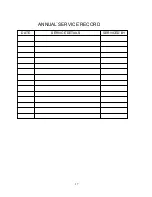
The IRRC Model 400 portable remote thermostat supplied with RMT models has two modes –
MANUAL and AUTOMATIC. You can switch between these modes by pressing the small AUTO/MANU
button after first pressing the large centre OFF/ON (OI) button to turn the control on. The control is ‘ON’
when the ‘flame’ symbol shows on the display. The display also shows a number of horizontal bars
indicating the flame height. The more bars, the higher the flame. When set on ‘AUTO’, the fire may light on
a low flame setting, and since it transmits to the receiver only about every three minutes, it may take up to
twenty minutes to reach a high flame setting automatically. If this is too slow and immediate heat is
required, switch to ‘MANUAL’, select a high flame by pressing the right button repeatedly until all the
horizontal bars are displayed and then return to the ‘AUTO’ setting.
MANUAL MODE OPERATION
In this mode the central OI button successively lights and extinguishes the burner. While the remote is
‘ON’, the left t button decreases the flame size, while the right s button increases it. The room temperature
is displayed at the left.
AUTO MODE OPERATION
In this mode the central OI button switches the fire on (provided that the SET temperature, the desired
room temperature, is greater than the displayed ROOM temperature) and off (when the ROOM
temperature is greater than the SET temperature). The left t button lowers the SET temperature, while the
right s button increases it. The SET temperature is displayed below the ROOM temperature. Note that the
flame size automatically reduces below the maximum as the room temperature nears the set temperature,
finally shutting down altogether. If the remote is ‘ON’ in the ‘AUTO’ mode, and it is POINTING
TOWARD THE HEATER, it will regulate the flame size to maintain the desired room temperature.
• About ten minutes after lighting the fire, you may turn on the fan by rotating the fan switch in either
direction. The fan has three speeds and ‘OFF’, and it is also controlled by an internal switch which will not
permit it to start until the fire is hot (about ten minutes after lighting). The fan will keep running for some
time after the fire goes out.
PROGRAMMING THE REMOTE CONTROL
The control can be programmed to operate the heater at a desired later time. The controls for this are under
the sliding cover below the display. Programming instructions are in the instruction sheet supplied with the
remote control.
NOTE: Occasionally the electrical system may ‘lock up’. Turning off the mains supply for ten seconds will
clear this.
ECS MODELS:-
These have a remote control handpiece and thermostat connecting terminals on the rear of the heater. If the
wall thermostat is not fitted, a small wire bridging loop must be fitted across these terminals or the heater
will not light. If the battery operated wall thermostat is fitted, it must be switched to ‘HEAT’ (under the
bottom hinged cover) and the SET temperature must be above the prevailing ROOM temperature before
the heater will light. The SET temperature can be altered by pressing the + and – buttons alongside the
display. If there is no display, check the thermostat batteries (3 x AA alkaline).
• To avoid the risk of backburning, do not attempt to re-light the fire less than three minutes after it has been
extinguished.
• Check that the power switch at the wall is ‘ON’ and press the top round handpiece button while aiming the
handpiece toward the receiver on the right front corner of the pedestal foot. The red indicator light on the
handpiece should light and the red indicator light alongside the receiver (on the pedestal foot) should light
in response and remain alight after the handpiece button is released. If the handpiece indicator does not
light up, check the handpiece batteries (4xAAA cells). If the receiver indicator does not light, press the
small button alongside the receiver (on the pedestal foot). If the receiver indicator still does not light, press
the red ‘RESET’ button on the back of the heater and try again.
• As soon as the receiver indicator lights, a thirty second ignition sequence begins. After about three seconds
from the start, there will be a continuous spark at the pilot electrode which will light the pilot. When
starting for the first time, there will probably be air in the pilot line supply pipe, so ignition may not occur
immediately. If it has not lit within about thirty seconds, the spark will cease. In this event, press the red
RESET button on the back of the heater and try
4






































